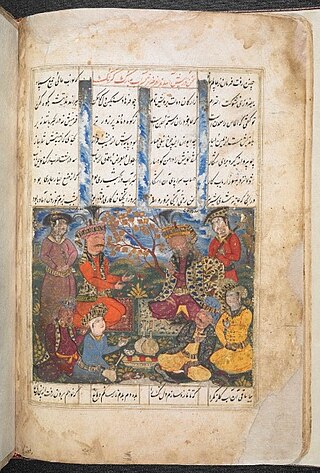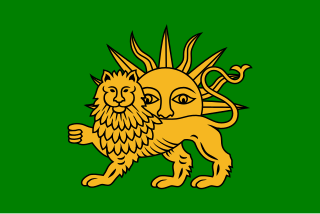Related Research Articles

A velayat was a type of administrative division within Safavid Iran, which functioned as a semi-autonomous province.
Ardalan was a hereditary Kurdish vassaldom in western Iran from around the 14th century until 1865 or 1868 with Sanandaj as capital. The territory corresponded roughly to present-day Kurdistan Province of Iran and the rulers were loyal to the Qajar Empire. Baban was its main rival. Gorani was the literary language and lingua franca. When the vassaldom fell, literary work in Gorani ceased.

Suleiman I was the eighth and the penultimate Shah of Safavid Iran from 1666 to 1694. He was the eldest son of Abbas II and his concubine, Nakihat Khanum. Born as Sam Mirza, Suleiman spent his childhood in the harem among women and eunuchs and his existence was hidden from the public. In 1666, after the death of his father, the nineteen-year-old Sam Mirza was crowned king under the regnal name, Safi II, after his grandfather, Safi I. He had a troublesome reign as Safi II, which convinced his court astrologers that he should undergo a coronation once again. Thus, in 20 March 1668, simultaneously with Nowruz, he was crowned king with a new name, Suleiman I.

Allahverdi Khan was an Iranian general and statesman of Georgian origin who, initially a gholām, rose to high office in the Safavid state.
Shaykh Ali Khan Zanganeh, was an Iranian statesman of Kurdish origin, who served as the grand vizier of the Safavid king (shah) Suleiman I from 1669 to 1689. Due to his efforts in reforming the declining Iranian economy, he has been called the "Safavid Amir Kabir" in modern historiography.

Sanandaj is a city in the Central District of Sanandaj County, in the Kurdistan province of Iran, serving as the capital of the district, the county and the province. With a population of 414,069, Sanandaj is the twenty third largest city in Iran and the second largest Kurdish city.
Zarrinnaal or Zarrin Naal is the name of a dynasty of Kurdish tribal chiefs and state officials belonging to the Zarrin Kafsh tribe and originated from Sanandaj in Kurdistan Province of Iran. Their heads with the title of Beyg, Beyk or Beg (lit."lord") were the Aghas of Senneh and ruled their fiefdom during the time of four hundred years when the Safavids, Afsharids and finally Qajar dynasty reigned in Iran.
Mohammad Khan Tokhmaq Ustajlu, also commonly known as Tokhmaq Khan Ustajlu, was a 16th-century Iranian official, diplomat and military leader from the Turkoman Ustajlu tribe. He was appointed as governor (beglarbeg) of Erivan Province in 1568–1575. Thereafter, he led an embassy to the Ottoman Empire. On his return, he participated in some judicial developments, and was reappointed as governor of Erivan Province in 1578. In the same year, he served as main commander at the Battle of Çıldır during the Ottoman–Safavid War of 1578–1590, where his army was routed. A few years later, in 1583, Mohammad Khan Tokhmaq's second tenure over the Erivan Province was brought to an end due to encroachments by the Ottomans, who controlled the province until 1604.

The province of Georgia was a velayat (province) of Safavid Iran located in the area of present-day Georgia. The territory of the province was principally made up of the two subordinate eastern Georgian kingdoms of Kartli and Kakheti and, briefly, parts of the Principality of Samtskhe. The city of Tiflis was its administrative center, the base of Safavid power in the province, and the seat of the rulers of Kartli. It also housed an important Safavid mint.

The Safavid occupation of Basra (1697–1701) took place between 26 March 1697 and 9 March 1701. It was the second time that the important Persian Gulf city had fallen to the Iranian Safavid Empire.
Iranian Kurdistan or Eastern Kurdistan is an unofficial name for the parts of northwestern Iran with either a majority or sizable population of Kurds. Geographically, it includes the West Azerbaijan Province, Kurdistan Province, Kermanshah Province, Ilam Province and parts of Hamadan Province and Lorestan Province.

Rudolph P. Matthee, best known as Rudi Matthee, is John and Dorothy Munroe Distinguished Professor of History in the History Department at the University of Delaware, teaching Middle Eastern history and specializing in the history of early modern Iran. He received his PhD in 1991 from the University of California. Matthee is a member of the Association for the Study of Persianate Societies, for which he also functioned as president twice in 2003-2005 and 2009–2011. He is the author of numerous books and articles on Safavid and Qajar Iran.

The province of Khuzestan was a southwestern province of Safavid Iran, corresponding to the present-day province of Khuzestan.
The province of Lorestan was a western province of Safavid Iran, corresponding to the present-day provinces of Ilam and Lorestan. It was one of the five velayats of the country, and was thus ruled by a vali.
The province of Kurdistan was a western province of Safavid Iran, whose size varied throughout its existence due to political and military developments.
Khosrow Khan Ardalan was the Ardalan beglerbeg (governor) of Kurdistan from 1680 to 1682. He was unpopular amongst his subjects, who claimed that his rule was oppressive. He was counselled several times to improve his way of governing, but they all proved ineffective. As a result, he was summoned to Isfahan, where he was executed at the Royal Square. He was replaced by Timur Khan Ajarlu Shamlu, the first non-Kurdish governor of the province.
Timur Khan Ajarlu Shamlu was the Safavid-appointed governor of Kurdistan from 1682 to 1688. Following the execution of the unpopular governor Khosrow Khan Ardalan, Shah Solayman had him replaced with Timur Khan, who became the first non-Kurdish governor of the province. Since Timur Khan was a foreigner with no connection to the province, he was eventually chased out by the locals. In 1688, he was replaced by Khan Ahmad Khan II Ardalan.
Khan Ahmad Khan Ardalan was the Ardalan beglerbeg (governor) of Kurdistan from 1617/18 to 1637. Before his tenure, he lived as a hostage at the royal court in Isfahan, where he spent his adolescence. There he reinforced the bond between the Safavids and Kurds by marrying Zarrin Kolah, a daughter of Shah Abbas I. In 1617/18, Shah Abbas I dismissed Khan Ahmad Khan's father Halow Khan Ardalan as the governor of Kurdistan and had him sent to Isfahan, where he died in 1627/28. Khan Ahmad Khan was sent to Ardalan in his stead. In 1633, Khan Ahmad Khan rebelled after his two sons were blinded by Shah Safi. Khan Ahmad Khan was defeated in 1637 and died in the same year. He was replaced by his cousin Soleyman Khan Ardalan.
Abbasqoli Khan Ardalan was the Ardalan beglerbeg (governor) of Safavid Kurdistan from 1710 to 1724. Abd al-Karim Qazi, a leading religious leader in Ardalan played a role in this appointment. It appears that Abbasqoli Khan's alleged prominent performance during the retaliatory expedition against the Ghilzay leader Mirwais Hotak—who rebelled in Kandahar in 1709—was at least part of the reason for his appointment.
References
- 1 2 Floor 2008, p. 228.
- ↑ Yamaguchi 2021, p. 564.
- ↑ Floor 2008, pp. 227–228.
- ↑ Floor 2008, p. 227.
- 1 2 Yamaguchi 2021, p. 565.